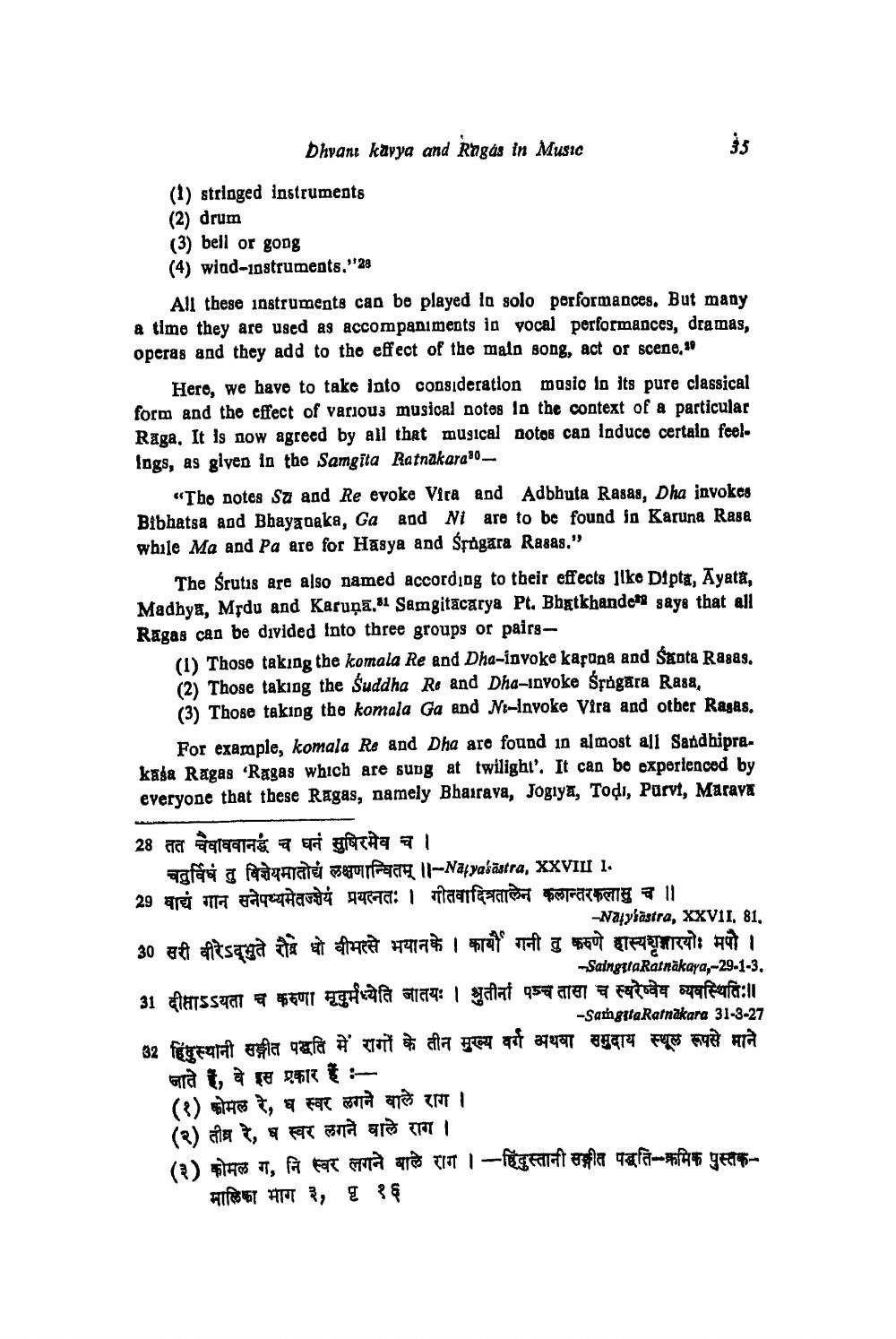________________
Dhvanı kavya and Ragas in Music
(1) stringed instruments (2) drum (3) bell or gong (4) wind-Instruments."28
All these instruments can be played la solo performances. But many a time they are used as accompaniments in yocal performances, dramas, operas and they add to the effect of the main song, act or scene, 19
Hero, we have to take into consideration music in its pure classical form and the effect of various musical notes in the context of a particular Raga. It is now agreed by all that musical notos can induce certain feel. Ings, as given in the Samgita Ratnakarado
"Tho notes Sa and Re evoke Vira and Adbhuta Rasag, Dha invokes Bibhatsa and Bhayangka, Ga and Ni are to be found in Karuna Rasa while Ma and Pa are for Hasya and Srugara Rasas."
The Śrutis are also named according to their effects like Dipta, Ayată, Madhyaa, Mrdu and Karuna.si Samgitacarya Pt. Bhatkhanden says that all Ragas can be divided into three groups or pairs
(1) Thoso takingthe komala Re and Dha-invoke karuna and Santa Raaas. (2) Those taking the Suddha Re and Dha-Invoke Srngara Rasa, (3) Those taking the komala Ga and Ne-Invoke vira and other Rasas.
For example, komala Re and Dha are found in almost all Sandhipra. kasa Ragas "Ragas which are sung at twilight'. It can be expertenced by everyone that these Ragas, namely Bhairava, Jogiya, Todi, Purvt, Marava
28 तत चैवाघवानद्धं च धनं सुषिरमेव च ।
चतुर्विषं तु विज्ञेयमातोचं लक्षणान्वितम् ||-Natyasastra, xxVIII I. 29 वाद्यं गान सनेपथ्यमेतज्ज्ञेयं प्रयत्नतः । गीतवादित्रतालेन कलान्तरकलासु च ॥
-Nafylāstra, XXVII, 81, 30 सरी वीरेऽद्भुते रोने धो वीभत्से भयानके । कायौँ गनी तु करणे हास्यशृङ्गारयोः मपौ ।
Saingtta Ratnākaya,-29-1-3. 31 दीक्षाऽऽयता च करुणा मूदुर्मध्येति जातयः । श्रुतीनां पञ्च तासा च स्वरेष्वेव व्यवस्थितिः।।
-SangstaRatnakara 31-3-27 32 हिंदुस्थानी सङ्गीत पद्धति में रागों के तीन मुख्य वर्ग अथवा समुदाय स्थूल रूपसे माने
जाते हैं, वे इस प्रकार हैं:(१) कोमल रे, ध स्वर लगने वाले राग । (२) तीन रे, ध स्वर लगने वाले राग । (३) कोमल ग, नि स्वर लगने वाले राग । -हिंदुस्तानी सङ्गीत पद्धति-क्रमिक पुस्तक
मालिका भाग ३, पृ १६




